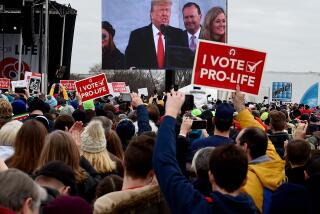Bushâs first veto
IN 5-1/2 YEARS AS PRESIDENT, George W. Bush has seen more than 1,100 bills cross his desk. Some were good pieces of law. Some were shortsighted and silly, and many flat-out contradicted the presidentâs own stated values, especially in the areas of fiscal prudence and free trade. He held his nose and signed them anyway.
On Wednesday, after the longest veto-free streak since Thomas Jefferson, Bush wiped the cobwebs from his veto pen and finally wielded a presidentâs most potent legislative weapon. To which there can only be two responses: Itâs about time -- and he shouldnât have.
By rejecting a bill that would have lifted some federal restrictions on funding for stem cell research, Bush handed a political victory to social conservatives, widened a rift in the Republican Party and gave electoral ammunition to his Democratic opponents. Oh, and he also landed quite a blow against scientific progress and human health. At his first veto ceremony, Bush piously surrounded himself with children who were adopted while still embryos in fertility clinics. The kids were telegenic symbols of the potential embedded in each human embryo, but entirely disingenuous ones; the bill Bush rejected wouldnât have prevented a single one of them from being born.
Fertility clinics destroy thousands of embryos every year, byproducts of the in-vitro fertilization process. The bill would have allowed federal funding only for stem cell lines made from embryos that were destined for destruction, not adoption. No lives will be saved by the presidentâs veto, but itâs quite possible that many will be lost, victims of complications of diseases that embryonic stem cells could one day cure.
The stem cell issue is often cited as an example of a rift in the Republican Party between social and fiscal conservatives (19 Republicans in the Senate supported the stem cell bill). Bushâs veto showed which side heâs on, especially considering all the irresponsible spending bills he has allowed to become law. He looked the other way last year when Congress approved a $286-billion transportation bill larded with extras, including the notorious âbridge to nowhereâ in Alaska. His commitment to free trade is only evident when it has no political cost, as he showed in 2002 when he approved a farm bill that reversed years of progress in reducing wasteful agricultural subsidies.
Disappointing as it is that Bush chose to use his first veto on this bill, at least he is finally using the constitutionally approved method of squashing bills. The presidential signing statement, formerly little more than a widely ignored news release, has under this administration become a sort of unofficial line-item veto, allowing the president to state publicly which parts of bills he intends to follow and which he will ignore. The Sarbanes-Oxley law, the USA Patriot Act and a measure by Sen. John McCain (R-Ariz.) outlawing torture have been stamped with Bushâs interpretations during signing statements, a disturbing seizure of executive branch power.
Now that Bush has shown that the ink cartridge hasnât dried up in his veto pen, he should use it more often. Next time, though, he should try not to use it to crush the hopes of millions of suffering Americans in order to please a radical special interest.
More to Read
Get the L.A. Times Politics newsletter
Deeply reported insights into legislation, politics and policy from Sacramento, Washington and beyond. In your inbox three times per week.
You may occasionally receive promotional content from the Los Angeles Times.










